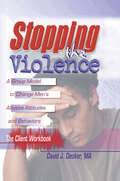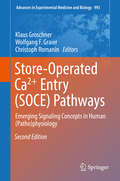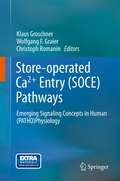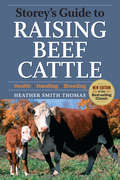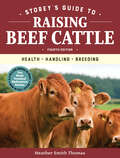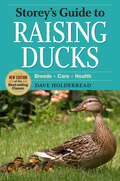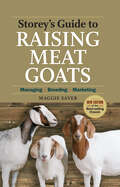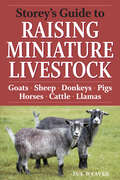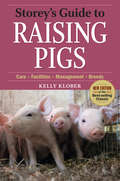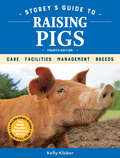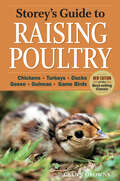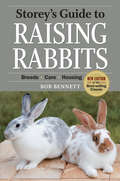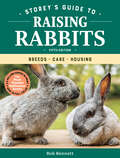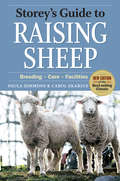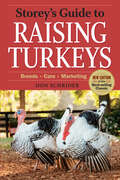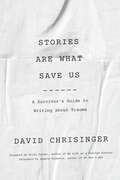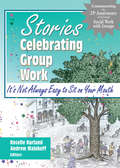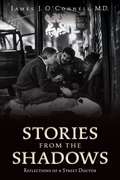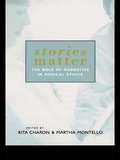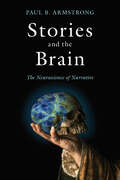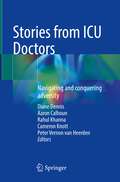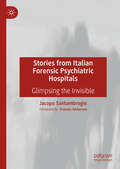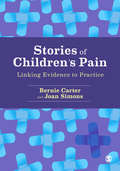- Table View
- List View
Stopping The Violence: A Group Model To Change Men's Abusive Attitudes And Behaviors
by David J DeckerThis informative and helpful guide will assist your clients in making positive strides toward a nonviolent life. Some of the tips and suggestions that are further explained in this workbook include: Acknowledge to yourself and to others that you have a problem with anger, abuse, and control Address mental health and chemical use issues if they are present in your life Come to know that, when you become abusive, you are always feeling inadequate, powerless, and unlovable Realize that controlling and abusive behavior hurts you and those you love Understand that anger is different from abuse and control Recognize that becoming abusive is always a choice Instead of blaming others, take responsibility for what you feel, how you think, and how you act Accept that you cannot control or change other people Remember that you can always take a time-out Think about the possible consequences before you become controlling and abusive Identify what triggers your anger and your abusive and controlling attitudes and behaviors Notice what you are thinking: Your thoughts can increase your escalation or calm you down Become aware of all your feelings, not just your anger, and learn to respectfully communicate them to others Turn conflicts into positive problem-solving opportunities Control, abuse, and violence are learned: Think about the messages you received from your family and from society about what it is to be a man Redefine manhood as nonviolent and nonabusive Take the risk to count on other men for emotional support Learn to feel a genuine sense of pride by taking control of how you view the world and how you act Start to believe that you can truly change the controlling and abusive parts of who you have been
Store-Operated Ca²⁺ Entry (SOCE) Pathways
by Klaus Groschner Christoph Romanin Wolfgang F. GraierStore-operated Ca2+ entry (SOCE) serves to control essential functions throughout the human body and represents a novel and attractive target for therapeutic intervention. This book provides an extensive overview of the role of SOCE pathways in Molecular Physiology and Cell Biology, as well as their clinical significance. (Patho)physiological principles and emerging therapeutic strategies are delineated in a way that is valuable both for the education of graduate students in advanced Cell Biology/Molecular Physiology and for the promotion of innovative research and developments in the clinical/therapeutic fields. A comprehensive, clear and elaborate representation of current concepts is provided, including a pathophysiological section arranged in a tissue/organ/system-oriented manner. The book is intended for basic researchers specializing in cell signaling, ion transport, or pharmacology, as well as biomedical scientists and clinicians with a focus on immunology, neurology or cardiology.
Store-operated Ca2+ entry (SOCE) pathways
by Klaus Groschner Wolfgang Graier Christoph RomaninStore-operated Ca2+ entry (SOCE) serves to control essential functions throughout the human body and represents a novel and attractive target for therapeutic intervention. This book provides an extensive overview of the role of SOCE pathways in Molecular Physiology and Cell Biology, as well as their clinical significance. (Patho)physiological principles and emerging therapeutic strategies are delineated in a way that is valuable both for the education of graduate students in advanced Cell Biology/Molecular Physiology and for the promotion of innovative research and developments in the clinical/therapeutic fields. A comprehensive, clear and elaborate representation of current concepts is provided, including a pathophysiological section arranged in a tissue/organ/system-oriented manner. The book is intended for basic researchers specializing in cell signaling, ion transport, or pharmacology, as well as biomedical scientists and clinicians with a focus on immunology, neurology or cardiology.
Storey's Guide to Raising Beef Cattle, 3rd Edition: Health, Handling, Breeding (Storey’s Guide to Raising)
by Heather Smith ThomasWhether you’re raising one cow or a herd, this comprehensive guide shows you everything you need to know to successfully manage your beef cattle operation. Heather Smith Thomas stresses the importance of understanding bovine behavior while covering breed selection, calving, feeding, housing, medical care, and humane slaughter practices. Along with in-depth information on raising grass-fed animals and dealing with toxic pasture plants, you’ll also find advice on creating a viable business plan and identifying niche markets for your beef.
Storey's Guide to Raising Beef Cattle, 4th Edition: Health, Handling, Breeding (Storey’s Guide to Raising)
by Heather Smith ThomasWhether a farmer is raising one cow or a herd, Storey&’s Guide to Raising Beef Cattle is the most reliable reference for ensuring a successful, healthy cattle operation. In this fully updated, full-color fourth edition, long-time cattle rancher and author Heather Smith Thomas explains every aspect of bovine behavior and provides expert guidance on breed selection, calving, feeding, housing, pasture, and health care. Along with in-depth information on raising grass-fed animals, there is also advice on creating a viable business plan and identifying niche markets for selling beef. This publication conforms to the EPUB Accessibility specification at WCAG 2.0 Level AA.
Storey's Guide to Raising Dairy Goats, 4th Edition: Breeds, Care, Dairying, Marketing (Storey’s Guide to Raising)
by Jerry Belanger Sara Thomson BredesenA great choice for the small or backyard farmer, dairy goats require a smaller investment than cows and produce milk that makes delicious yogurt and cheese. This fourth edition includes more on pygmy goats, health care, breeding, and making dairy products. You’ll have everything you need to you need to know to successfully raise your own dairy goats.
Storey's Guide to Raising Ducks, 2nd Edition: Breeds, Care, Health (Storey’s Guide to Raising)
by Dave HolderreadWith in-depth information on feeding, housing, behavior, and health care, this comprehensive guide also provides proven strategies for creating a profitable business plan and marketing your products. Whether you&’re about to acquire your first ducks or are interested in experimenting with rare breeds, Storey&’s Guide to Raising Ducks will help you achieve your duck-raising goals.
Storey's Guide to Raising Meat Goats, 2nd Edition: Managing, Breeding, Marketing (Storey’s Guide to Raising)
by Maggie SayerDiscover how raising your own meat goats can be a fun and profitable endeavor. Offering plenty of tips for creating an economically viable operation and identifying niche markets for your products, Storey&’s Guide to Raising Meat Goats shows you how to care for a thriving and productive herd full of healthy and happy animals.
Storey's Guide to Raising Miniature Livestock: Goats, Sheep, Donkeys, Pigs, Horses, Cattle, Llamas (Storey’s Guide to Raising)
by Sue WeaverWhether you want to the make most of a small plot of land or add diversity to a large farm, raising miniature livestock can be a fun and profitable experience. With expert advice on choosing a breed that suits your needs, Sue Weaver shows you how to house, feed, and care for miniature goats, sheep, donkeys, pigs, horses, cattle, and llamas. You’ll be inspired by profiles of successful breeders as you learn everything you need to know to keep your miniature livestock healthy and productive.
Storey's Guide to Raising Pigs, 3rd Edition: Care, Facilities, Management, Breeds (Storey’s Guide to Raising)
by Kelly KloberLearn how to successfully raise your own pigs. Stressing the importance of sustainable and environmentally friendly farming practices, Kelly Klober provides expert tips on making your hog operation more efficient and profitable. Storey’s Guide to Raising Pigs will give beginners the confidence they need to succeed, while inspiring experienced farmers to try new techniques and experiment with new breeds.
Storey's Guide to Raising Pigs, 4th Edition: Care, Facilities, Management, Breeds (Storey’s Guide to Raising)
by Kelly KloberFarmer Kelly Klober provides expert advice on making any size hog operation more efficient and profitable in Storey’s Guide to Raising Pigs. The most comprehensive book available on the topic, this fourth edition features the most up-to-date information and practices, illustrated with color photography. Sustainable and environmentally friendly farming practices are stressed. Both beginners and experienced farmers will find all the information they need to select, house, care for, breed, and butcher pigs, along with marketing advice. This publication conforms to the EPUB Accessibility specification at WCAG 2.0 Level AA.
Storey's Guide to Raising Poultry, 4th Edition: Chickens, Turkeys, Ducks, Geese, Guineas, Game Birds (Storey’s Guide to Raising)
by Glenn DrownsWhether you’re running a farm or interested in keeping a few backyard birds, Storey’s Guide to Raising Poultry covers everything you need to know to successfully raise your own chickens, turkeys, waterfowl, and more. Stressing humane practices throughout, Glenn Drowns provides expert advice on breed selection, housing, feeding, behavior, breeding, health care, and processing your own meat and eggs. With tips on raising specialty species like doves, ostriches, and peafowl, you’ll be inspired to experiment with new breeds and add diversity to your poultry operation.
Storey's Guide to Raising Rabbits, 4th Edition: Breeds, Care, Housing (Storey’s Guide to Raising)
by Bob BennettWhether you’re interested in raising rabbits for show, meat, fur, or as pets, this comprehensive guide covers everything you need to know to keep your animals healthy and productive. Offering expert advice on breed selection, housing, feeding, humane handling, routine medical care, and dealing with diseases, Bob Bennett also provides tips on how to make raising rabbits a financial lucrative endeavor. Storey’s Guide to Raising Rabbits will help both the commercial producer and the backyard fancier achieve their rabbit-raising goals.
Storey's Guide to Raising Rabbits, 5th Edition: Breeds, Care, Housing (Storey’s Guide to Raising)
by Bob BennettThe fifth edition of this best-selling handbook features the same detailed approach that has made it the trusted source for raising healthy, productive rabbits — plus a total redesign with color photos and graphics. Whether you’re interested in raising rabbits for show, meat, fur, or as pets, this comprehensive guide offers expert advice on breed selection, housing, feeding, humane handling, and more. In addition, author Bob Bennett includes the most up-to-date information on preventive health care, treating diseases, marketing, and showing. This publication conforms to the EPUB Accessibility specification at WCAG 2.0 Level AA.
Storey's Guide to Raising Sheep, 4th Edition: Breeding, Care, Facilities (Storey’s Guide to Raising)
by Paula Simmons Carol EkariusDrawing from years of hands-on experience, Paula Simmons and Carol Ekarius provide expert advice on breed selection, lambing, feeding, housing, pasture maintenance, and medical care. You’ll also find tips on profitably marketing your meat and fiber products, as well as information on obtaining organic certifications.
Storey's Guide to Raising Sheep, 5th Edition: Breeding, Care, Facilities (Storey’s Guide to Raising)
by Paula Simmons Carol EkariusStorey’s Guide to Raising Sheep is the best-selling, most trusted reference for farmers and backyard homesteaders with any size flock. The fifth edition is now updated with full-color illustrations and photographs throughout, including a gallery of the best breed choices for both meat and fiber. With their small size and gentle dispositions, sheep are one of the easier livestock species to raise and offer varied marketing opportunities, including meat, wool, and milk. Detailed instructions and graphics lead readers through every essential procedure, including shearing, building a lambing shed, breeding and lambing, butchering, and marketing. This publication conforms to the EPUB Accessibility specification at WCAG 2.0 Level AA.
Storey's Guide to Raising Turkeys, 3rd Edition: Breeds, Care, Marketing (Storey’s Guide to Raising)
by Don SchriderTurkeys are an excellent source of succulent meat, rich eggs, and nutrient-dense manure, and raising them is a rewarding and profitable activity for many farmers. With helpful tips on acquiring organic certification, processing both meat and eggs, and marketing your products, you’ll have all the information you need to successfully raise your own healthy and productive turkeys.
Stories Are What Save Us: A Survivor's Guide to Writing about Trauma
by David ChrisingerA seasoned writer and teacher of memoir explores both the difficulties inherent in writing about personal trauma and the techniques for doing so in a compelling way.Since 2013, David Chrisinger has taught military veterans, their families, and other trauma survivors how to make sense of and recount their stories of loss and transformation. The lessons he imparts can be used by anyone who has ever experienced trauma, particularly people with a deep need to share that experience in a way that leads to connection and understanding. In Stories Are What Save Us, Chrisinger shows—through writing exercises, memoir excerpts, and lessons he's learned from his students—the most efficient ways to uncover and effectively communicate what you've learned while fighting your life's battles, whatever they may be. Chrisinger explores both the difficulties inherent in writing about personal trauma and the techniques for doing so in a compelling way. Weaving together his journey as a writer, editor, and teacher, he reveals his own deeply personal story of family trauma and abuse and explains how his life has informed his writing. Part craft guide, part memoir, and part teacher's handbook, Stories Are What Save Us presents readers with a wide range of craft tools and storytelling structures that Chrisinger and his students have used to process conflict in their own lives, creating beautiful stories of growth and transformation. Throughout, this profoundly moving, laser-focused book exemplifies the very lessons it strives to teach. A foreword by former soldier and memoirist Brian Turner, author of My Life as a Foreign Country, and an afterword by military wife and memoirist Angela Ricketts, author of No Man's War: Irreverent Confessions of an Infantry Wife, bookend the volume.
Stories Celebrating Group Work: It's Not Always Easy to Sit on Your Mouth
by Andrew Malekoff Roselle KurlandStories Celebrating Group Work: It&’s Not Always Easy to Sit on Your Mouth celebrates the 25th anniversary of the esteemed journal Social Work with Groups with a collection of 21 narratives from group work practitioners and educators. These highly personal stories from a range of social workers-young and old, "famous" and not so famous-reflect each author's development and experience, serving as both instruction and inspiration for practitioners and educators. This unique collection-by turns humorous, moving, profound, and down-to-earth-gets to the heart of what it means to be a member of the social work community. Each chapter of Stories Celebrating Group Work draws on its contributor&’s area of expertise and interest in a specific topic, chronicling the development of the author's understanding, appreciation, and skill. Authors address the everyday concerns of social work professionals, such as maximizing mutual aid, promoting positive norms, maintaining authority in group work, managing conflict, dealing with taboo subjects, building a group work culture in a human services organization, working with a co-leader, tapping the strengths of group members, and addressing social change. The individual stories of working with men, women, and children suffering through abuse, homelessness, addiction, and teenage pregnancy, in places as diverse as East Harlem, Maine, Canada, Nebraska, Long Island, Haiti, Uruguay, help form a collegial spirit as group workers gain insight from the theory and practice of those who went before. The personal stories you&’ll find in Stories Celebrating Group Work include: "How I Became a Social Worker" "The Power of Group Work with Kids" "How the Relational Model of Group Work Developed" "My Love Affair with Stages of Group Development" "But I Want to Do a Real Group" "Racial Difference and Human Commonality: The Worker-Client Relationship" and many more! Stories Celebrating Group Work: It&’s Not Always Easy to Sit on Your Mouth is a one-of-a-kind collection of stories, at once entertaining and educational. It's an essential read for beginning and seasoned human services practitioners, and educators involved with, or interested in, working with groups.
Stories From The Shadows: Reflections Of A Street Doctor
by James J. O'ConnellDr. O'Connell's collection of stories and essays, written during thirty years of caring for homeless persons in Boston, gently illuminates the humanity and raw courage of those who struggle to survive and find meaning and hope while living on the streets.
Stories Matter: The Role of Narrative in Medical Ethics (Reflective Bioethics)
by Martha Montello Rita CharonFirst published in 2002. Routledge is an imprint of Taylor & Francis, an informa company.
Stories and the Brain: The Neuroscience of Narrative
by Paul B. ArmstrongThis book explains how the brain interacts with the social world—and why stories matter.How do our brains enable us to tell and follow stories? And how do stories affect our minds? In Stories and the Brain, Paul B. Armstrong analyzes the cognitive processes involved in constructing and exchanging stories, exploring their role in the neurobiology of mental functioning. Armstrong argues that the ways in which stories order events in time, imitate actions, and relate our experiences to others' lives are correlated to cortical processes of temporal binding, the circuit between action and perception, and the mirroring operations underlying embodied intersubjectivity. He reveals how recent neuroscientific findings about how the brain works—how it assembles neuronal syntheses without a central controller—illuminate cognitive processes involving time, action, and self-other relations that are central to narrative.An extension of his previous book, How Literature Plays with the Brain, this new study applies Armstrong's analysis of the cognitive value of aesthetic harmony and dissonance to narrative. Armstrong explains how narratives help the brain negotiate the neverending conflict between its need for pattern, synthesis, and constancy and its need for flexibility, adaptability, and openness to change. The neuroscience of these interactions is part of the reason stories give shape to our lives even as our lives give rise to stories.Taking up the age-old question of what our ability to tell stories reveals about language and the mind, this truly interdisciplinary project should be of interest to humanists and cognitive scientists alike.
Stories from ICU Doctors: Navigating and conquering adversity
by Rahul Khanna Cameron Knott Diane Dennis Aaron Calhoun Peter Vernon van HeerdenThe intensive care unit (ICU) is a specialised hospital ward where the ‘sickest-of-the-sick’ patients, often with life-threatening illness, receive around-the-clock monitoring and life support. There is a wide spectrum of conditions managed, and these present unique challenges for those who work in this field. Written in lay language by experienced ICU doctors (Intensivists), Psychiatrists, healthcare professionals outside of medicine and other stakeholders, “Stories from ICU doctors” provides insight and commentary around the nature and management of stressors for senior doctors working in the ICU. The first five sections of the book describe the distinctive nature of the ICU environment: the human factors involved, the characteristics of thriving Intensivists, the emotions they experience, and how they behave in response. The final three sections provide a synthesis of the advice of these clinicians for both current and future Intensivists, the advice from those who surround the Intensivist both at work and at home; and some concluding remarks about trainee suitability and selection for intensive care medicine. This book is for ICU patients and their families, it is for the families of ICU doctors, it is for doctors from other specialities, it is for the nurses and others that work alongside ICU doctors, and for anyone considering a career in ICU medicine and those who care for them. We share these stories in hope that readers might better appreciate the human side of these doctors, better understand the complex working environment in which they practice, and perhaps better empathize with their stressors and struggles. Most importantly, this book is also for the ICU doctors who currently work within the specialty, to validate their feelings and experiences, and ultimately provide support by reminding them that they are not alone in navigating the difficulties they face.
Stories from Italian Forensic Psychiatric Hospitals: Glimpsing the Invisible
by Jacopo SantambrogioThis book offers reflections on emerging issues in psychiatry today, told through the lens of interviews conducted with patients of the former Forensic Psychiatric Hospitals in Italy. Using narrativization, this book brings together clinical cases told in the first person which have allowed the author to develop insights into these issues. The author considers the patient/offender who poses a series of questions about mental illness itself, its origins, the factors related to its onset, such as substances, differential diagnosis, treatment paths (both pharmacological and rehabilitative) and the cultural factors that may influence the outcomes, providing invaluable insights for clinicians, researchers and students of Psychiatry and Psychology in international settings.
Stories of Children's Pain: Linking Evidence to Practice
by Bernie Carter Ms Joan SimonsWorking with a child in pain is difficult, unavoidable and especially challenging when the child cannot explain what they are feeling. In this important book, Bernie Carter and Joan Simons bring together experience, evidence and research to deconstruct the topic and present the reality of children's pain. Each chapter starts with a personal story from a child, a family member or a healthcare professional. The stories are drawn from a wealth of original research, and focus the reader on the individual child and their family. The chapter then goes on to introduce the relevant research, theory and implications for practice, so health professionals can use the evidence to support compassionate, child-centred care. Among the topics addressed are: - Ethical dilemmas - Assessing pain - Working in different settings - Inexplicable pain It is valuable reading for any healthcare student or professional working with children of all ages.
